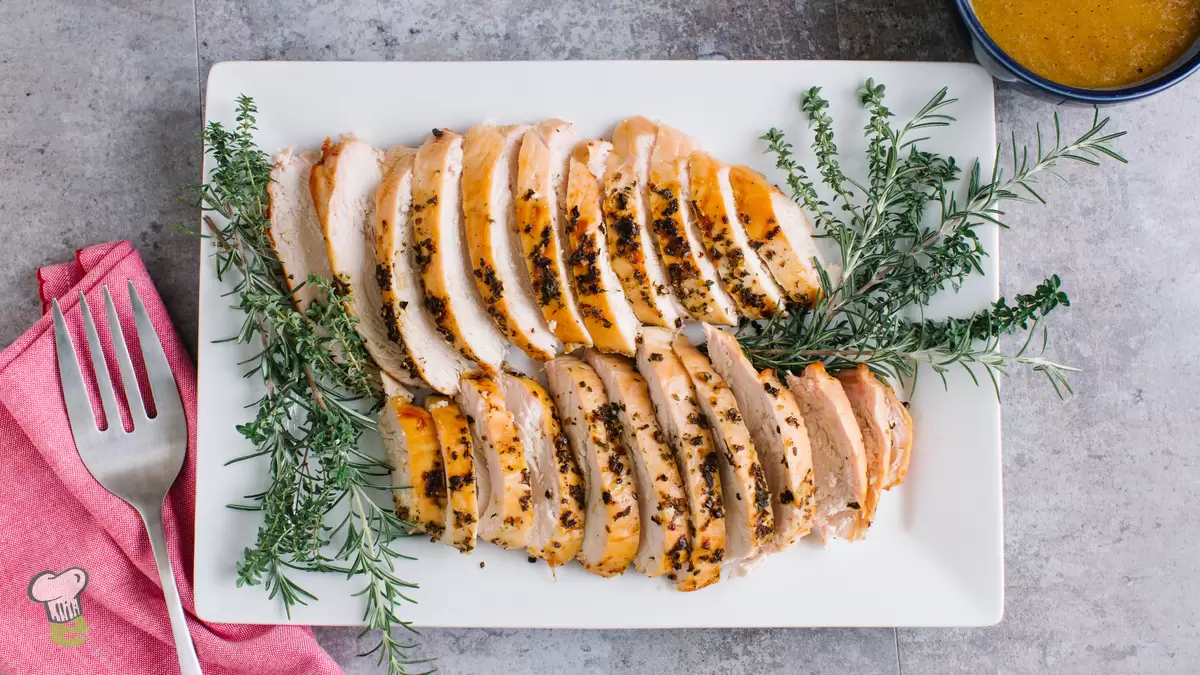Join Our Newsletter
Get our best recipes and health tips delivered right to your inbox!

This simple and healthy roasted turkey breast recipe has all the great flavor of the whole bird without the fuss. Try your hand at this heart-healthy, herb-infused dish and never look at dinner the same way again. We'll show you the key steps to guarantee a juicy result, including the ideal roasting temperature.
If you are planning a smaller Thanksgiving or holiday meal, this roasted turkey breast offers all the classic flavor without the time and effort of a whole bird, making it the perfect solution for an intimate, stress-free celebration. For even more holiday inspiration, be sure to explore all of our delicious and healthy turkey recipes.
This roasted turkey breast is a heart-healthy choice primarily because it focuses on lean protein while minimizing saturated fat and sodium. By removing the skin and using herbs for flavor instead of salt, it delivers a satisfying main course that aligns with cardiac-conscious eating patterns.
Turkey breast has a bad reputation for being healthy only when it’s dry and bland. However, let’s dive into the reasons why this moist and flavorful roasted turkey breast recipe is healthy:
Both temperatures work well, but roasting at a lower temperature like 325°F cooks the turkey more gently and can result in a moister, more tender breast. Roasting at a higher temperature like 350°F or even 400°F will cook it faster but requires more careful monitoring to prevent drying out.
A 6-pound bone-in turkey breast typically takes about 1 3/4 to 2 hours to roast at 400°F. Always use a meat thermometer and cook until the internal temperature reaches 165°F in the thickest part.
Yes, tenting the turkey breast with foil for the initial part of the roasting process helps trap steam and moisture, preventing the surface from drying out before the inside is cooked. You can remove the foil for the last 20-30 minutes to allow the top to brown nicely.
The safest and most reliable internal temperature for a fully cooked turkey breast is 165°F (74°C). Insert a meat thermometer into the thickest part of the breast, avoiding the bone, to check for doneness.
If you enjoyed making this heart-healthy roasted turkey, explore our other simple main courses. Each recipe is designed to be nutritious and flavorful, helping you expand your collection of go-to healthy meals.
To make your Heart-Healthy Roasted Turkey Breast a complete meal, explore our favorite healthy side dishes. These recipes are perfect pairings, from classic mashed potatoes to flavorful roasted vegetables that your family will love.
Roasted turkey breast is easy to cook! Here are a few tips and tricks to make sure your roasted turkey breast is moist and flavorful:
Recipe yields 8 servings
Preheat oven to 400°. Rinse the turkey breast and pat dry. In a small bowl, combine the butter, garlic, shallot, sage, thyme, salt and pepper to taste and rub the mixture onto the turkey breast. Place turkey breast on a rack in a roasting pan. Roast in the middle of the oven until a meat thermometer inserted into thickest part of breast registers 165° or juices run clear when a paring knife is poked in the thickest part of breast, about 1 3/4 to 2 hours. Transfer to a cutting board and let rest.
Meanwhile, pour the drippings from the roasting pan into a glass cup. With a spoon, skim off the fat. ln a small saucepan, heat the drippings over medium heat and stir in flour. Cook, stirring, for 1 minute, or until light brown. Whisk in the chicken broth and cider and season with pepper to taste. Cook, stirring frequently, until gravy thickens, 3 to 4 minutes. Serve the turkey breast with the gravy and garnished with thyme sprigs, if desired.
While oven-roasting provides the best traditional flavor and browning, you can adapt this recipe for other methods:
You can use an equal amount of olive oil or another heart-healthy oil to rub on the turkey before roasting.
If you don't have fresh sage or thyme, you can use dried herbs. Use 1 teaspoon of dried herbs for every 1 tablespoon of fresh herbs called for.
To ensure the gravy is low in sodium, use unsalted or low-sodium chicken broth. Vegetable broth is also a suitable alternative.
As noted in the article, substitute the all-purpose flour with a gluten-free all-purpose flour blend to make the gravy gluten-free.